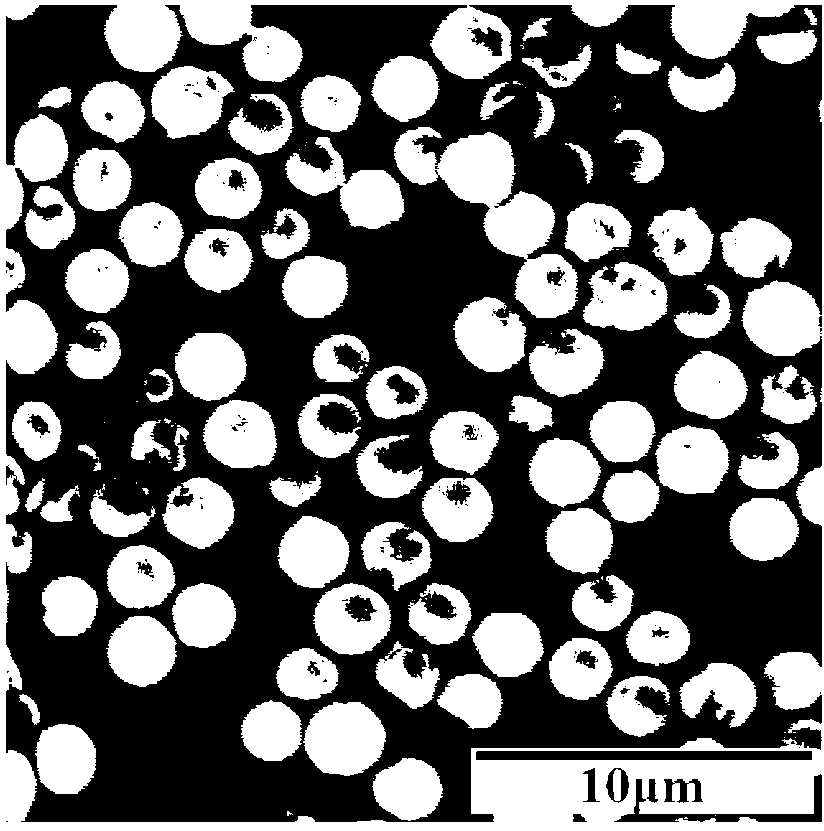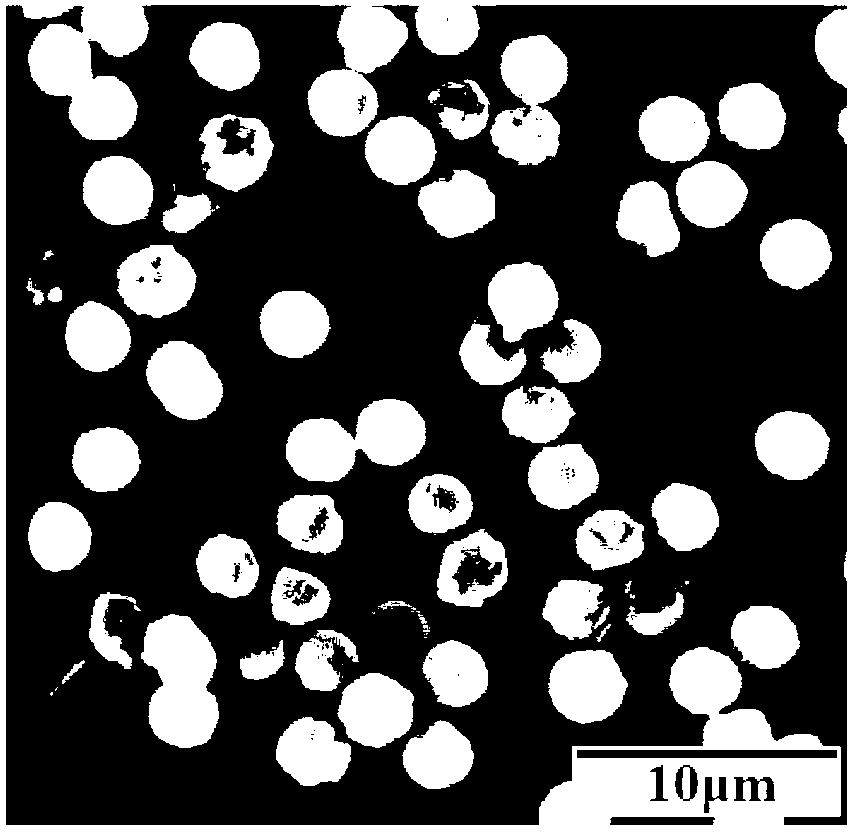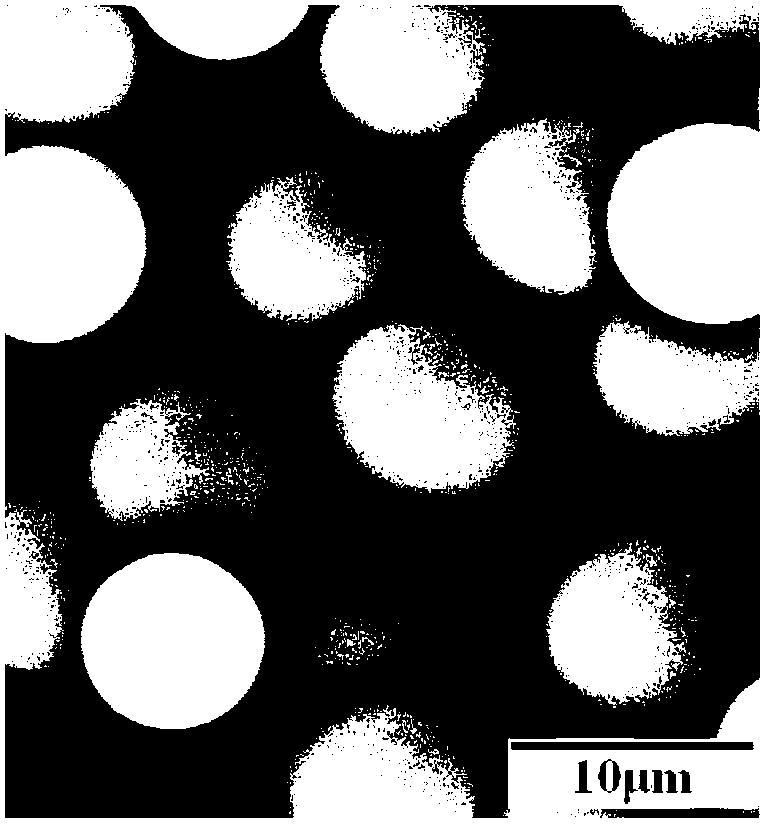Method for preparing micro-sized monodisperse polyurea microsphere in static condition
A micron-scale, monodisperse technology, applied in the field of preparation of micron-scale monodisperse polyurea microspheres, micron-scale monodisperse polymer microspheres, can solve the problem of low monomer conversion rate and microsphere yield, monodisperse microspheres Problems such as low production efficiency of spheres and continuous operation of equipment are needed to achieve the effects of high complete conversion of monomers, fast polymerization reaction rate and low cost
- Summary
- Abstract
- Description
- Claims
- Application Information
AI Technical Summary
Problems solved by technology
Method used
Image
Examples
Embodiment 1
[0039] At room temperature, first add 98.0 g of water / acetone mixed solvent with a mass ratio of 30 / 70 to a 120 mL glass reaction bottle, shake well and then add 2.0 g of 4,4′-dicyclohexylmethane diisocyanate (CAS No.: 5124-30-1) monomer, seal the reaction bottle, shake it well and put it in a constant temperature water bath at 30°C. After 80 minutes of reaction, the system starts to become cloudy, and then continue to react for 2 hours. After the reaction, take a certain amount of sample and add it to a centrifuge tube, centrifuge at 12000r / min for 5min with a high-speed centrifuge, take out the supernatant, wash the microspheres twice with acetone, and then dry them in an oven at 85°C for 10h Polyurea microspheres were obtained.
[0040] The productive rate of gained polyurea microsphere is 68.11%, and the average particle diameter of microsphere is 1.923 μ m, and the polydispersity coefficient of particle diameter is 1.028, and its scanning electron micrograph is as follows...
Embodiment 2
[0042] Add 98.0g of water / acetone mixed solvent with a mass ratio of 30 / 70 to a 120mL glass reaction bottle at room temperature, shake well and then add 2.0g of 1,6-hexamethylene diisocyanate (CAS No.: 822-06- 0) monomer, seal the reaction bottle, shake it well and put it in a constant temperature water bath with a temperature of 30°C. After 75 minutes of reaction, the system starts to become cloudy, and then continue to react for 2 hours. After the reaction, take a certain amount of sample and add it to a centrifuge tube, centrifuge at 12000r / min for 5min with a high-speed centrifuge, take out the supernatant, wash the microspheres twice with acetone, and then dry them in an oven at 85°C for 10h Polyurea microspheres were obtained.
[0043] The productive rate of gained polyurea microsphere is 69.43%, and the average particle diameter of microsphere is 2.101 μ m, and the polydispersity coefficient of particle diameter is 1.035, and its scanning electron micrograph is as follo...
Embodiment 3
[0045] At room temperature, first add 91.0 g of water / acetone mixed solvent with a mass ratio of 24 / 76 to a 120 mL glass reaction bottle, shake well and then add 9.0 g of isophorone diisocyanate (CAS No.: 4098-71-9 ), the reaction bottle was sealed and shaken evenly and placed in a constant temperature water bath at a temperature of 30°C. After 85 minutes of reaction, the system began to become cloudy, and then continued to react for 2 hours. After the reaction, take a certain amount of sample and add it to a centrifuge tube, centrifuge at 12000r / min for 5min with a high-speed centrifuge, take out the supernatant, wash the microspheres twice with acetone, and then dry them in an oven at 85°C for 10h Polyurea microspheres were obtained.
[0046] The productive rate of gained polyurea microsphere is 88.39%, and the average particle diameter of microsphere is 8.425 μ m, and the polydispersity coefficient of particle diameter is 1.007, and its scanning electron micrograph is as fo...
PUM
| Property | Measurement | Unit |
|---|---|---|
| particle diameter | aaaaa | aaaaa |
| particle size | aaaaa | aaaaa |
| particle size | aaaaa | aaaaa |
Abstract
Description
Claims
Application Information
 Login to View More
Login to View More - R&D
- Intellectual Property
- Life Sciences
- Materials
- Tech Scout
- Unparalleled Data Quality
- Higher Quality Content
- 60% Fewer Hallucinations
Browse by: Latest US Patents, China's latest patents, Technical Efficacy Thesaurus, Application Domain, Technology Topic, Popular Technical Reports.
© 2025 PatSnap. All rights reserved.Legal|Privacy policy|Modern Slavery Act Transparency Statement|Sitemap|About US| Contact US: help@patsnap.com



